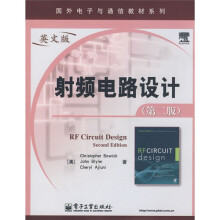Chapter l Components and Systems
1.1 WIRE
1.1.1 Skin Effect
1.1.2 Straight-Wire Inductors
1.2 RESISTORS
1.2.1 Resistor Equivalent Circuit
1.3 CAPACITORS
1.3.1 Parallel-Plate Capacitor
1.3.2 Real-World Capacitors
1.3.3 Capacitor Types
1.4 INDUCTORS
1.4.1 Real-World Inductors
1.4.2 Single-Layer Air-Core Inductor Design
1.4.3 Magnetic-Core Materials
1.5 TOR01DS
1.5.1 Core Characteristics
1.5.2 Powdered Iron vs. Ferrite
1.6 TOROIDAL INDUCTOR DESIGN
1.7 PRACTICAL WINDING HINTS
Chapter 2 Resonant Circui
2.1 SOME DEFINITIONS
2.2 RESONANCE (LOSSLESS COMPONENTS)
2,3 LOADED Q
2.3.1 Effect of R, and RL on the Loaded Q
2.3.2 The Effect of Component Q on Loaded Q
2.4 INSERTION LOSS
2.5 IMPEDANCE TRANSFORMATION
2.6 COUPLING OF RESONANT CIRCUITS
2.6.1 Capacitive Coupling
2.6.2 Inductive Coupling
2.6.3 Active Coupling
2.7 SUMMARY
Chapter 3 Filter Design
3.1 BACKGROUND
3.2 MODERN FILTER DESIGN
3.3 NORMALIZATION AND THE LOW-PASS PROTOTYPE
3.4 FILTER TYPES
3.4.1 The Butterworth Response
3.4.2 The Chebyshev Response
3.4.3 The Bessel Filter
3.5 FREQUENCY AND IMPEDANCE SCALING
3.6 HIGH-PASS FILTER DESIGN
3.7 THE DUAL NETWORK
3.8 BANDPASS FILTER DESIGN
3.9 SUMMARY OF THE BANDPASS FILTER DESIGN PROCEDURE.
3.10 BAND-REJECTION FILTER DESIGN
3.11 THE EFFECTS OF FINITE Q
Chapter 4 Impedance Matching
4. l BACKGROUND
4.2 THE L NETWORK
4.3 DEALING WITH COMPLEX LOADS
4.4 THREE-ELEMENT MATCHING
4.4.1 The Pi Network
4.4.2 The T network
4.5 LOW-Q OR WIDEBAND MATCHING NETWORKS
4.6 THE SMITH CHART
4.6.1 Smith Chart Construction
4.6.2 Basic Smith Chart Tips
4.6.3 Plotting Impedance Values
4.6.4 Impedance Manipulation on the Chart
4.6.5 Conversion of Impedance to Admittance
4.6.6 Admittance Manipulation on the Chart
4.7 IMPEDANCE MATCHING ON THE SMITH CHART
4.7.1 Two-Element Matching
4.7.2 Three-Element Matching
4.7.3 Multi-Element Matching
4.8 SOFTWARE DESIGN TOOLS
4.8.1 Smith Chart Tools
4.8.2 Integrated Design Tools
4.9 SUMMARY
Chapter 5 The Transistor at Radio Frequencies
5.1 RF TRANSISTOR MATERIALS
5.2 THE TRANSISTOR EQUIVALENT CIRCUIT
5.2.1 Input Impedance
5.2.2 0utput Impedance
5.2.3 Feedback Characteristics
5.2.4 Gain
5.2.5 Transistor as a Switch
5.2.6 MEMs as a Switch
5.3 Y PARAMETERS
5.3.1 The Transistor as a Two-Port Network
5.3.2 Two-Port Y Parameters
5.4 S PARAMETERS
5.4.1 Transmission Line Background
5.4.2 S Parameters and the Two-Port Network
5.5 UNDERSTANDING RF TRANSISTOR DATA SHEETS
5.6 SUMMARY
Chapter 6 Small-Signal RF Amplifier Design
Chapter 7 RF(Large Signal)Power Amplifiers
Chapter 8 RF Front-End Design
Chapter 9 RF Design Tools
Appendix A RF And Antennas
Appendix B Vector Algebra
Bibliography

 缺书网
缺书网 扫码进群
扫码进群
